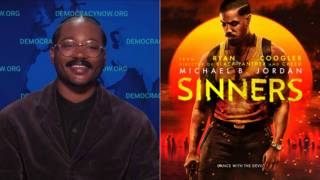
Following last week’s record-breaking East Coast heat wave, a new study by Stanford University climate scientists says as global warming continues, such heat waves will be increasingly common in the future. The study found exceptionally long heat waves and other hot events could become commonplace in the United States in the next thirty years, posing serious risks to agriculture and human health. [includes rush transcript]
Transcript
JUAN GONZALEZ: Well, 2010 is shaping up to be a dangerously hot summer. The National Weather Service issued a heat advisory this week that stretches from Louisiana to Minnesota, warning temperatures may hit 110 degrees. In Kansas and Oklahoma, it may feel as hot as 115 degrees, as central parts of the country brace for “dangerously” high readings. Temperatures also hit record levels across the US last week, as readings here in New York hit 103 and passed 100 in Newark for four days in a row.
AMY GOODMAN: Well, you may have to get used to the heat. As global warming continues, such heat waves will be increasingly common, this according to a new study by Stanford University climate scientists. The study found exceptionally long heat waves and other hot events could become commonplace in the United States in the next thirty years, posing serious risks to agriculture and human health.
Noah Diffenbaugh is assistant professor of environmental earth system science at Stanford and lead author of the study. He’s joining us from Stanford University.
Thanks so much for joining us. Lay out what you found.
NOAH DIFFENBAUGH: Well, we’ve used a large suite of climate models to try to understand how extreme hot events might change going forward over the next three decades. And we’re particularly interested in this time period because of the current policy considerations that are considering a two-degree C, Centigrade, warming envelope. And so, this is a relatively moderate global warming envelope, and so we’re trying to understand what risks that level of moderate warming might play. And what we found is that, frankly, to my surprise, there’s potentially a substantial intensification of extreme hot events throughout the United States within this global warming envelope over the next thirty years.
JUAN GONZALEZ: And you reviewed data for how far back, in terms of developing your model?
NOAH DIFFENBAUGH: Well, the models are a physical representation of the climate system. And then we give the models different greenhouse gas concentrations in order to run controlled experiments on the climate system. And we’ve used as a baseline the second half of the twentieth century, and so we’ve looked at a variety of extreme heat metrics over the second half of the twentieth century — for example, the hottest season that occurred during the second half of the twentieth century or the longest heat wave that occurred over the second half of the twentieth century. And then we increased the greenhouse gas concentrations in the climate models going forward, and we ask, in each decadal period, so the decade we’re starting now, the 2020s and the 2030s, how often are those extreme thresholds exceeded? So, for example, for the hottest season that has occurred over the second half of the twentieth century, we find that by the decade of the 2030s, we can see something from five, even up to nine, exceedances per decade of what was the one and five decade hottest season.
AMY GOODMAN: So, aside from discomfort, we’re talking about more wildfires, droughts. What else, Noah Diffenbaugh?
NOAH DIFFENBAUGH: Well, we know that severe heat can be very stressful for natural and human systems at present, whether it’s the health effects of heat waves or the effects on important agricultural crops such as corn and soybeans. Also, there are well-known relationships with wildfire from hot, dry conditions. And so, when — part of our motivation for looking at the extreme was to ask, what’s the hottest events that we’ve been conditioned to over a long period of time? What’s the envelope that we’re used to? What’s the extreme of that envelope? And within this global warming target that’s been at least initially agreed upon in the Copenhagen Accord, what’s the potential that we might see conditions that are even more hot than the rare event that we’re accustomed to? And so, although we’re still working on the specific impacts, we can look at the current stresses that those kind of events provide, and from that, we can infer that this may be an increased stress going forward. And as I mentioned, I was surprised to see that the increases were as large as they are in our results over a relatively near-term period, over the next three decades.
AMY GOODMAN: Your results suggesting that limiting global warming to two degrees Celsius doesn’t guarantee there won’t be damaging impacts on the environment.
NOAH DIFFENBAUGH: Well, I think that’s — I think it’s an important conclusion of the study. We obviously don’t know what’s going to happen over the next thirty years. But there has been a — there have been repeated statements that — including in the Copenhagen Accord, that the science is reporting that two degrees C needs to be the target. And the language is somewhat flexible, which is understandable. So, there’s no language in the accord that the two degree C is guaranteed to avoid dangerous climate change, but there has been a general sense that the message coming from the scientific community is that two degrees Centigrade warming is the target.
And I, frankly, as someone who studies relatively local climate change and the impacts of extreme events, was interested to know whether or not we would see changes in extremes that would be potentially meaningful for humans and for the biosphere within that global warming target. Frankly, I didn’t expect to see changes that were this large. We’re looking at what has been very rare event, for our common experience, becoming a common event in the relatively near-term future.
AMY GOODMAN: Noah Diffenbaugh, I want to thank you for being with us, assistant professor of environmental earth system science at Stanford.













Media Options